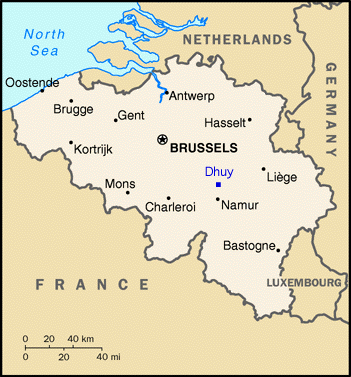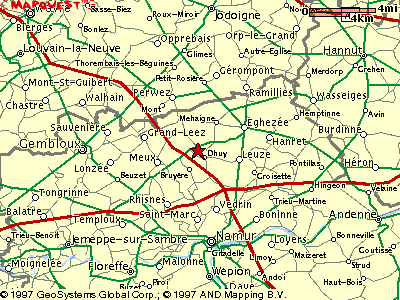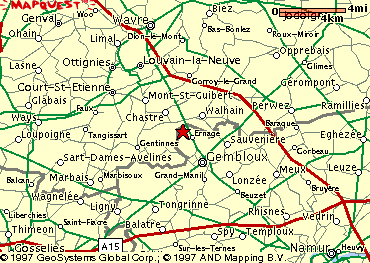
The family name Dhuey is unique in the United States of America in the sense that all known persons with that name are descended from one Belgian immigrant, Jean Joseph Dhuy (1818-1911), who arrived with his wife and son in America in 1856 and settled in the Belgian-American community of northeast Wisconsin.



The surname itself, which is pronounced "DWEE" in Walloon-speaking Belgium, is taken from the Belgian village of Dhuy, located in the province of Namur about ten miles southeast of Jean Joseph's hometown of Ernage (see map). Dhuy was formed in the middle ages from three fiefs1. Its name can be found as early as the twelfth century, spelled "Duis," and is derived from the Latin ductis, meaning "by the channels."2 The "Dhuy" spelling can be found as early as 1263, when the Count of Namur gave to Libert of Dhuy all his real estate in the area.
There are several brooks and streams in France named Dhuy, Dhuis, Duy, Dhuye, Dhuys, and similar variations. According to a gazetteer of France, the words are related to the French word doux, meaning "fresh water."3 Whatever the variations, the common idea is that "Dhuy" is a name of hydrographic origin, referring to sources of fresh water.
Jean Joseph's American-raised children began gradually to add the "e" to the name (the earliest recorded use was in 1884), and the spelling "Dhuy" was abandoned after 1905. The lives of rural nineteenth century farmers were uncluttered by the paperwork we live with today, and a typical person would have had very, very few occasions when it was necessary to write out his or her name &emdash; if they could write at all. More often a priest, lawyer, or county clerk would be on hand to do the job. Add to that the problems of a Walloon-speaking people in an English-speaking land, and you have the numerous misspellings and attempted phonetic spellings throughout that period.
How do we know the Dhuey name is unique? The International Genealogical Index (IGI), published by the Family History Department of the Latter-day Saints (Mormon) Church, is a microfiche print-out of over 80 million names of deceased persons. The IGI consists of entries from names submitted by professional and amateur genealogists from information taken from family and original records, or by trained extractors who enter information from birth and marriage records, church registers, probate records, and census enumerations worldwide. A state-by-state search through the United States section, as well as a province-by-province search through the Belgium section, has failed to show any other Dhuey family in either country. Even the spelling "D'huy" produced exactly one entry, in Kentucky.
A Dhuy/Dhuey search through all of the birth, marriage, and death indexes in the Wisconsin Vital Records Office revealed only the descendants of Jean Joseph Dhuy.
The Passenger and Immigration Lists Index lists 1,775,000 persons (out of an estimated 20,000,000) who immigrated to North America from 1538 to 1900; no Dhuy or Dhuey is among them4.
In addition, American Indexing Systems has produced a master microfiche index of those U.S. Census records, tax rolls, and other miscellaneous records which have been individually indexed in book form on a state-by-state basis. A search through the 1790-1850 period (later indexing is still in progress) has similarly revealed no Dhueys, and only one Dhuy, in the United States.
One can also search in vain through the telephone directories of major American cities for an unrelated Dhuey. Even the telephone directory for the city of Brussels, Belgium, does not contain any Dhuey or Dhuy listings. The 35 volumes of Belgium's Biographie Nationale contain over 17,000 biographies, none of which is of a Dhuy.5 A few Dhuys are known to still live in the provinces of Hainaut and Brabant today, including Jean Joseph's great-great-granddaughter Monique.
And so we come back to Jean Joseph Dhuy. This book is a complete record of the Dhuey name in America through 1989; although everyone with that name is descended from Jean Joseph, it is not a complete record of all of his descendants. Family lines are followed only insofar as they carry on the Dhuey name. To have followed all of the lines of descent would have greatly increased the length of this work; the fifth generation, for instance, would be about 16 times larger. In any case, it would have lost the focus of this book, the Dhuey name and its history.
The main part of this book, the biographical profiles, is arranged by generation. Within generations, the persons are grouped according to family branch in a standard genealogical arrangement. Women who married into the Dhuey family appear immediately after their husbands. For help in finding a particular person, refer to either the descendant chart, or the index at the end of the book.
The spelling of certain names became judgment calls. There seem to be as many ways to spell LeCapitaine and Finendale, for instance, as there are members of those families. Birth dates were another problem area. I normally take a baptismal or civil birth record to be accurate; if neither of those is available, the remaining pieces of evidence regarding a person's birth date are listed, no matter how much they disagree with each other.
The research for this book was done mainly at the following offices and institutions: The State Historical Society of Wisconsin (one of the nation's finest genealogical centers); the Wisconsin Vital Records Office; the Special Collections at the University of Wisconsin&emdash;Green Bay Library; St. Hubert's Church in Rosiere, Wisconsin; the Family History Library of the Latter-day Saints Church in Madison, Wisconsin; the Register in Probate Office of Kewaunee County, Wisconsin; and the Register of Deeds offices of Kewaunee and Brown counties, Wisconsin. To the staff people at these places I am grateful for their time and assistance.
Special thanks to Harris and Emily Dhuey for their hospitality and enthusiasm. Their help has been invaluable for both editions of this family history.
Finally, I thank all of the Dhuey relatives who have answered my questions and have lent photographs from their family albums. This book is as much from you as it is now for you.
2Maurice Bologne, Petit guide étymologique des noms des régions, des villes, des villages et des rivières de Wallonie, Connaitre la Wallonie, vol. 11 (Nalinnes-Charleroi, Belgium: Institut Jules Destrée, 1970), p. 45.
3 Paul Joanne, Dictionnaire geographique et administratif de la France et de ses colonies, Paris, 1892, vol. 2, pp. 1228-1229.
4P. William Filby (ed.) with Mary K. Meyer. Passenger and Immigration Lists Index. Detroit: Gale Research Co., 1981, with annual supplements through 1997.
5L'Académie Royale des Sciences, des Lettres et des Beaux-Arts de Belgique. Biographie Nationale. 35 vols. Brussels: L'Académie, 1866-1969.